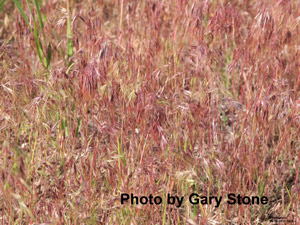March 2014
 Cheatgrass, also known as downy brome, military grass, and downy chess, is a winter annual grass that was introduced from southwestern Asia in the late 1800's. It was first reported in British Columbia and has since spread throughout western North America. It is now moving into grasslands of the Midwest.
Cheatgrass, also known as downy brome, military grass, and downy chess, is a winter annual grass that was introduced from southwestern Asia in the late 1800's. It was first reported in British Columbia and has since spread throughout western North America. It is now moving into grasslands of the Midwest.
Cheatgrass is an invasive plant species that reduces forage quality and increases the potential for large and more frequent fires. It grows from 6 - 24" with distinguishing features of hairy leaves and stems, ligule with fringed margin, and drooping panicles. It has been reported that a heavy infestation of cheatgrass can produce up to 80,000,000 seeds/acre.
Why is cheatgrass so successful? It is very competitive for available resources, primarily soil moisture. Since it typically germinates in the fall, develops roots during the winter, and begins re-growing as soon as temperatures begin warming in the spring, it has an advantage over most native and desirable rangeland and pasture species that emerge from dormancy later or have a slower growth habit. Another key feature of cheatgrass is its ability to thrive under frequent and intensive fire cycles.
Managing cheatgrass requires an integrated approach with a focus on breaking the seed cycle and maintaining or improving the vigor of desirable plant species. Several tools are available for managing cheatgrass, including mechanical, cultural, chemical, and biological.
- Cheatgrass seed populations in the soil can be reduced by cultivating to germinate and kill newly emerging seedlings.
- Herbicides can be used to prevent emergence and control existing cheatgrass populations, but care must be taken to not injure desirable plant species.
- Prescribed grazing can reduce populations and prevent new seed if applied at the right time and frequent enough without injuring perennial grasses.
- Finally, the establishment or maintenance of desirable vegetation is the most effective way to control cheatgrass at very minimal costs.
Remember to read and follow the label of any herbicide used and prevent the development of herbicide resistance by incorporating the use of all the available tools.
For additional information, see the UNL Extension NebGuide Downy Brome Control (PDF version 713KB) and Montana State University MontGuide Cheatgrass: Identification, Biology and Integrated Management (PDF 388KB).
Steve Young, PhD
Former Faculty
West Central Research & Extension Center
University of Nebraska–Lincoln